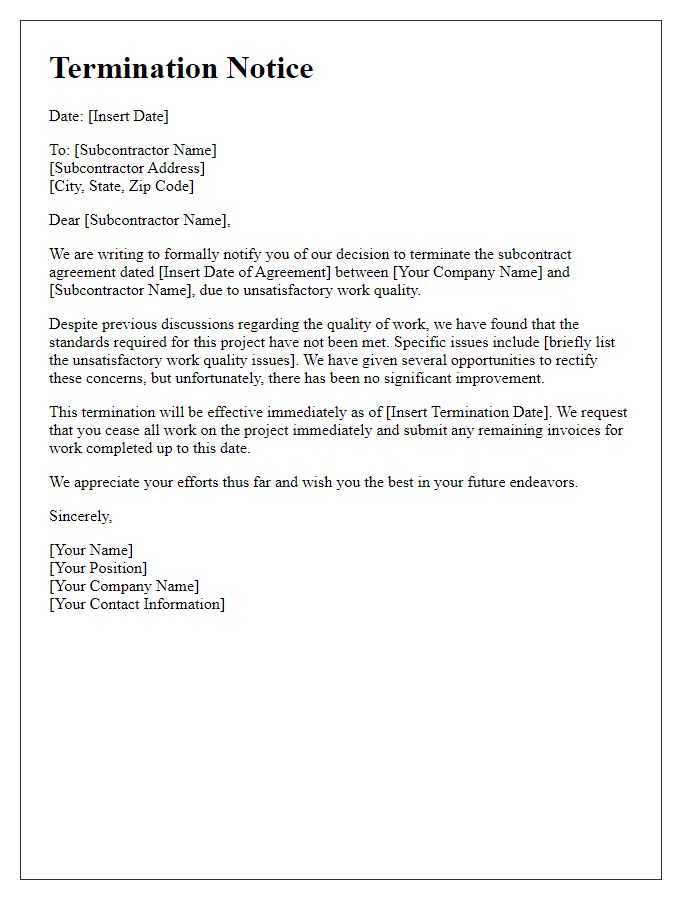In the fast-paced world of contracting, sometimes tough decisions need to be madeâlike terminating a subcontractor's agreement. Effective communication is key, and a well-crafted termination notice can help ensure that all parties are clear on the next steps. This letter not only outlines the reasons behind the termination but also promotes a professional and amicable disengagement. Curious about how to structure this important notice? Read on for an easy-to-use template!

Clear identification of parties involved
In the construction industry, subcontractor termination notices are critical documents that clearly identify the parties involved, ensuring all stakeholders understand their roles and responsibilities. The primary contractor, often referred to as the "General Contractor," takes the initiative to issue the termination notice to the subcontractor, who is responsible for a specific portion of the work, such as electrical, plumbing, or carpentry tasks. Each party must be precisely named, including any relevant business license numbers and addresses, to avoid confusion. Furthermore, the project name, location, and contract number should also be included to substantiate the context of the termination. This clarity is essential to prevent disputes and to uphold the legal integrity of the termination process in accordance with the contractual obligations stipulated in documents like the American Institute of Architects (AIA) contracts or the ConsensusDocs.
Explicit termination date
Subcontractor termination notices must clearly state the termination date as well as the reasons for termination. For example, if the termination date is set for September 30, 2023, this date should be emphasized to avoid confusion. In addition, articulation of any outstanding payments or pending deliverables, necessary for closing the project smoothly, enhances clarity in communication. Also, it is helpful to mention compliance with local contractual laws and regulations, ensuring the termination adheres to legal standards. Providing instructions regarding the return of company property can also maintain order in the termination process. Further documentation may be required for comprehensive record-keeping.
Reason for termination
Subcontractor termination notices often arise due to breaches of contract, poor performance, or failure to meet deadlines. A subcontractor may be terminated for consistently missing critical project milestones, such as the completion of designated tasks by set deadlines. This situation can create project delays, adversely impacting overall objectives. Reasons for termination can include inadequate quality of work, which may necessitate rework and cause additional expenses. Non-compliance with safety regulations, as outlined by OSHA (Occupational Safety and Health Administration), can also lead to termination, as it raises concerns about worker safety and project viability. Lack of communication from the subcontractor regarding updates or issues can further erode trust and systemic flow, compelling a decision to terminate the agreement.
Reference to contract clauses
Termination of a subcontractor agreement can be a complex process involving specific clauses outlined in the contract. The parties involved must understand the implications of contract clauses such as termination for convenience, termination for cause, and any required notice periods. Essential details include the effective date of termination, reasons for termination based on non-compliance or performance issues, and final settlement of outstanding payments related to the incurred services. It is crucial to reference specific clauses (e.g., Section 12: Termination Rights, Clause 3: Notice Requirements) to provide a clear legal basis for the notice. The subcontractor must be informed of their rights, obligations for returning materials, and any procedures regarding the handover of ongoing project responsibilities.
Instructions for final settlements and obligations
The termination of a subcontractor agreement requires careful consideration of obligations and final settlements. The subcontractor must be informed of the specific date of termination, ensuring compliance with the original contract signed in [specific date]. Payment obligations, such as outstanding invoices or work completed up to the termination date, should be clearly outlined, including an accurate accounting of total amounts due. All residual materials and equipment belonging to the main contractor, such as specialized machinery or tools, must be returned by the subcontractor to the designated location at [specific address or project site]. The subcontractor is responsible for completing any final documentation, such as lien waivers or release forms, by [specific deadline]. It's crucial to specify future obligations, including confidentiality clauses and non-compete agreements that remain in force after termination. Additionally, any potential disputes regarding the termination process can be outlined, referring to the mediation and arbitration procedures established within the original contract.
Letter Template For Subcontractor Termination Notice Samples
Letter template of subcontractor termination notice for breach of contract.

Letter template of subcontractor termination notice due to poor performance.

Letter template of subcontractor termination notice for project completion.

Letter template of subcontractor termination notice for non-compliance with regulations.

Letter template of subcontractor termination notice for financial disputes.

Letter template of subcontractor termination notice for failure to meet deadlines.

Letter template of subcontractor termination notice for unsatisfactory work quality.

Letter template of subcontractor termination notice for business closure.

Letter template of subcontractor termination notice following safety violations.





Comments